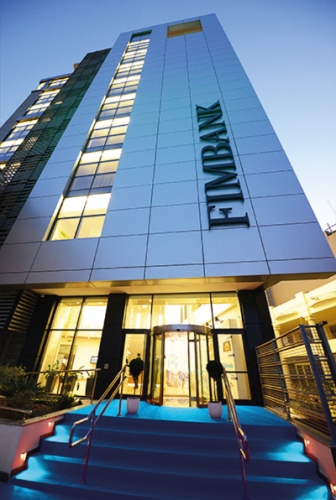Insights from FIMBank’s Head of Corporate Finance
In an engaging interview with Jason Zammit, FIMBank’s Head of Corporate Finance, Design & Build delves into the transformative landscape of banking and its integral role in Malta’s real estate sector.
Mr. Zammit offers insightful commentary on the contemporary factors shaping the industry, such as the dynamics of the rental market, the increase in foreign workforce, occupational health and safety standards, and the influence of environmental, social and governance (ESG) considerations within the financial sector.
FIMBank stepped into the real estate lending sector with the objective of delivering a dependable service, superior quality and consistent excellence to the market. The Bank assembled a dedicated and talented team of seasoned professionals to offer a comprehensive suite of products tailored specifically for developers. The target customers are established developers with a solid track record. The suite of products finances the land acquisition and development of projects for residential, commercial, and mixed-use.
These products are competitively priced with repayment schemes in line with the project’s sales or rental proceeds. The aim is to balance the developers’ cash flow to ensure project continuity and success. In furthering its commitment to cater for an expansive array of corporate needs in Malta, FIMBank recently broadened its spectrum of corporate banking services. This expansion includes the provision of overdraft facilities and working capital solutions, augmenting its already well-established repertoire of trade finance products.
Property investment has served as a cornerstone of Malta’s economy for countless generations. The consistent rise in property value is accelerated by land scarcity and limited alternative investments. Although backed by a strong economic track record, the property market’s resilience is not immune to the dynamics of supply, demand, and other factors.

Over the course of his thirty years’ experience in banking, Mr. Zammit appreciates the evolving industry and how this has been influenced by both local and external factors.
“Demand has been fuelled by societal changes, foreign labour influx, and shifting expectations leading to higher demands for residential units,” explains Mr. Zammit. The Maltese rental market is experiencing a vigorous revival, with substantial yield increases recorded in various areas within Malta. Based on the latest data from the Housing Authority, there has been a significant 25% surge in the number of people entering into rental contracts. A substantial total close to 48,000 rental agreements were registered in 2022. The average rent increased by almost 7% last year, with half of new tenants signing up to rental agreements of more than €800 a month. According to EY and DJAR’s 2022 Property Market report, the estimated average rental yield for a two-bedroom apartment last year was 7.36% in Sliema, 7.64% in St Julian’s, with Valletta commanding the highest national average at 8.18%. These figures attest to a thriving rental market in Malta, particularly in these prominent areas.
In Malta, the allure of real estate as a promising investment is not just confined to developers but also extends to the common household. This holds true even when the property may not be occupied, thus effectively transforming it into a ‘dormant’ asset, not producing any immediate monetary yield. Even with potential negative short-term returns due to maintenance costs, investors often favour real estate due to its long-term wealth generating potential.

Many see property, particularly in supply-constrained areas, as a promising asset likely to appreciate significantly over time. This view allows them to overlook immediate expenses, focusing instead on property’s robust potential as a safeguard against inflation and a substantial store of wealth.
“FIMBank stepped into the real estate lending sector with the objective of delivering a dependable service, superior quality and consistent excellence to the market”
On the topic of foreign labour influx, Mr. Zammit highlights that several sectors are increasingly reliant on foreign nationals. Presently, more than half of the workers in the construction industry are not locals. This inflow of foreign workers has stimulated a robust labour market and positive economic performance which has also led to a 25% increase in Malta’s population over the past few years. Navigating this development can pose a number of challenges for a small nation such as Malta. Maintaining the current momentum of expansion with Malta’s economic model would require continued population growth, an approach which exacerbates existing infrastructure pressures. Striking a balance between growth and long-term sustainability will prove vital in the coming years as the economic model transitions to adapt to new challenges.
Moving towards the topic of sustainable development, he states that the incorporation of Environmental, Social, and Governance (ESG) factors into the European Union’s regulatory framework has profound implications for banks.

Banks are now mandated to integrate ESG considerations into their strategies, risk management processes, and decision-making frameworks, essentially reshaping their operations in line with sustainability standards. Moreover, banks and financial institutions must demonstrate proactive measures towards mitigating climate change and other ESG-related risks, underpinning their commitment to a sustainable economy. “In the evolving landscape of property development, sustainability has emerged as a significant matter of discussion.”
“Based on the latest data from the Housing Authority, there has been a significant 25% surge in the number of people entering into rental contracts. A substantial total close to 48,000 rental agreements was registered in 2022”
Developers and investors are increasingly encouraged to prioritise the building of structures that guarantee minimal carbon footprint. This includes the development of buildings that are energy-efficient, use renewable resources, and designed to minimise waste. These eco-friendly initiatives not only reduce environmental harm but also bring about long-term economic benefits, leading to reduced operational costs. With growing awareness and anticipation surrounding this trend, sustainability is poised to further establish itself at the centre stage in the future of property development.

FIMBank’s rigorous evaluation process in assessing property development proposals
is based upon the Bank’s prudent lending standards.
When discussing bank lending procedures Mr. Zammit explains that structuring a property development transaction at FIMBank is a meticulous process. It begins with thorough due diligence, assessing the prospective borrower’s track record. Subsequently, a comprehensive analysis of the client’s project, its objectives, valuations, financial projections, and budgeted costs is undertaken. All of this is carried out while maintaining prudent lending standards and catering for creditworthy borrowers. When it comes to assessing property development proposals, FIMBank employs a rigorous evaluation process.
The process is not confined to the superficial elements of a project but involves a comprehensive analysis encompassing factors such as location, market dynamics, project promoters, the selected financing model, and the projected return on investment.
“Developers and investors are increasingly encouraged to prioritise the building of structures that guarantee minimal carbon footprint”
The evaluation of project promoters includes an analysis of financial stability, track record, and experience in successfully executing similar projects. The financing model’s feasibility and sustainability are thoroughly investigated, taking into account the overall financial health of the developers, the project’s risk profile, and the prevailing economic conditions. Lastly, a comprehensive examination of the projected return on investment is conducted, ensuring it aligns with FIMBank’s risk appetite. This process allows FIMBank to make informed lending decisions that support successful property development while ensuring the Bank’s financial stability and sustainability.
The industry is not without its challenges. Certainly, there is scope for a higher level of awareness, implementation, and enforcement. By prioritising the well-being of construction workers and employing advanced safety measures, property owners and developers can effectively ensure their workers’ safety.
“By prioritising the well-being of construction workers and employing advanced safety measures, property owners and developers can effectively ensure their workers’ safety”
This practice inherently decreases both the project’s risk and potential reputational hazards associated. Society also reaps considerable advantages from the continual enhancement of health and safety standards in construction. Safe and secure buildings contribute to a more resilient infrastructure, increasing the longevity and quality of properties. A commitment to worker well-being fosters a positive image for the construction industry, attracting a skilled workforce and boosting the economy. Ultimately, maintaining and improving health and safety standards in the construction industry is a shared responsibility that creates a more secure and prosperous environment for everyone involved, from workers to property owners, developers, and society.

When asked about the reasons as to why developers choose FIMBank for their real estate finance requirements, Mr. Zammit stated that FIMBank understands the diverse needs of its clients and offers personalised finance solutions. This commitment to customer-centricity enables the Bank to build strong, enduring relationships with its customers, fostering loyalty and trust. Through this approach, the Bank creates positive outcomes for customers and sets itself apart within the competitive banking industry. In his view, FIMBank is more than a mere provider of funds, it is a partner that fosters growth.
“FIMBank understands the diverse needs of its clients and offers personalised finance solutions”
In conclusion, Mr. Zammit underscores the importance of a professional approach, robust governance, stringent management controls, and transparency for a project’s success. A well-prepared project proposal enhances the Bank’s ability to conclude a timely and comprehensive assessment, ultimately increasing the probability of securing finance. He remains optimistic about FIMBank’s relationship with the property industry and sees several opportunities for sustainable growth through its understanding of the local property market and an efficient and transparent lending process. This collaborative approach ensures that both the Bank and its clients prosper together for many years to come.

Comment